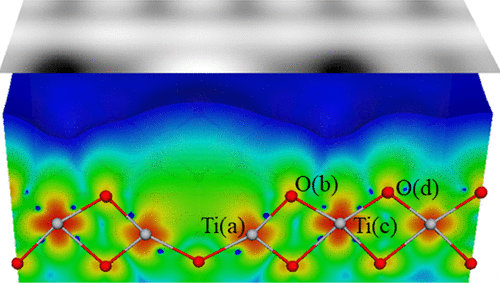Our official English website, www.x-mol.net, welcomes your
feedback! (Note: you will need to create a separate account there.)
Bias-Dependent Scanning Tunneling Microscopy Signature of Bridging-Oxygen Vacancies on Rutile TiO2(110)
ACS Omega ( IF 3.7 ) Pub Date : 2018-06-18 00:00:00 , DOI: 10.1021/acsomega.8b01056 Willie B. Maddox 1 , Danda P. Acharya 2 , G. Jeremy Leong 1 , Peter Sutter 3 , Cristian V. Ciobanu 1
ACS Omega ( IF 3.7 ) Pub Date : 2018-06-18 00:00:00 , DOI: 10.1021/acsomega.8b01056 Willie B. Maddox 1 , Danda P. Acharya 2 , G. Jeremy Leong 1 , Peter Sutter 3 , Cristian V. Ciobanu 1
Affiliation

|
The rutile TiO2(110) surface has long-served as a well-characterized, prototypical transition-metal oxide surface used in heterogeneous catalysis and photocatalytic water splitting. Naturally occurring defects on this surface, called bridging-oxygen (BO) vacancies, are important as they determine the overall reactivity of the surface. Herein, we report a bias-dependent, scanning tunneling microscopy (STM) signature of the BO vacancies on TiO2(110): for sample bias voltages past a threshold of +3 V, the bright vacancies are flanked on either side (along the oxygen row) by two dark spots approximately shaped like half-moons. The BO vacancies have a bright aspect below the threshold bias also but are not surrounded by half-moon dark depressions. Using generalized gradient approximation calculations with Hubbard correction (GGA + U) for projected density of states (DOS) and simulated STM images, we find that the bias-dependent STM signature originates from (i) local DOS maxima of all BOs (lighter background that occurs above the threshold bias) and (ii) the increased separation between the first and second BO atoms neighboring the vacancy which leads to an apparent dip between these neighboring oxygens. These results offer a new striking example of the STM signature that appears without switching the polarity of the bias. Similar approaches can be employed for seeking distinguishing features on the surfaces of other large band gap semiconductors and insulators.
中文翻译:

金红石TiO 2(110)上桥接氧空位的偏倚扫描隧道显微镜特征
金红石型TiO 2(110)表面长期用作特征非典型的过渡金属氧化物表面,用于非均相催化和光催化水分解。此表面上自然发生的缺陷(称为桥接氧(BO)空位)很重要,因为它们确定了表面的整体反应性。在这里,我们报告TiO 2上的BO空位的偏置依赖的扫描隧道显微镜(STM)签名。(110):对于超过+3 V阈值的样品偏置电压,明亮的空位在两侧(沿着氧气行)两侧有两个近似半月形的黑点。BO空位在阈值偏差以下也具有明亮的外观,但不被半月暗凹所包围。使用具有Hubbard校正(GGA + U)对于状态密度(DOS)和模拟STM图像的投影,我们发现与偏差有关的STM签名源自(i)所有BO的局部DOS最大值(出现在阈值偏差以上的较亮背景)和(ii)增加靠近空位的第一和第二个BO原子之间的分离导致这些相邻的氧之间出现明显的倾角。这些结果提供了一个新的STM签名醒目示例,该示例在不切换偏置极性的情况下即可出现。可以采用类似的方法来寻找其他大带隙半导体和绝缘体表面上的区别特征。
更新日期:2018-06-18
中文翻译:

金红石TiO 2(110)上桥接氧空位的偏倚扫描隧道显微镜特征
金红石型TiO 2(110)表面长期用作特征非典型的过渡金属氧化物表面,用于非均相催化和光催化水分解。此表面上自然发生的缺陷(称为桥接氧(BO)空位)很重要,因为它们确定了表面的整体反应性。在这里,我们报告TiO 2上的BO空位的偏置依赖的扫描隧道显微镜(STM)签名。(110):对于超过+3 V阈值的样品偏置电压,明亮的空位在两侧(沿着氧气行)两侧有两个近似半月形的黑点。BO空位在阈值偏差以下也具有明亮的外观,但不被半月暗凹所包围。使用具有Hubbard校正(GGA + U)对于状态密度(DOS)和模拟STM图像的投影,我们发现与偏差有关的STM签名源自(i)所有BO的局部DOS最大值(出现在阈值偏差以上的较亮背景)和(ii)增加靠近空位的第一和第二个BO原子之间的分离导致这些相邻的氧之间出现明显的倾角。这些结果提供了一个新的STM签名醒目示例,该示例在不切换偏置极性的情况下即可出现。可以采用类似的方法来寻找其他大带隙半导体和绝缘体表面上的区别特征。











































 京公网安备 11010802027423号
京公网安备 11010802027423号